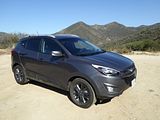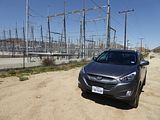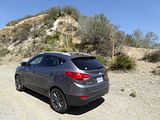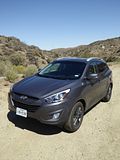


































































One of the most significant differences between the North American market Tucson models and the ix35 cars comes when you look under the bonnet. Although resistance had slowly been breaking down, at least until the VW emissions scandal story broke, most Americans think they are almost allergic to diesel, so the US Tucsons only come with petrol engines and an automatic gearbox, whereas few ix35 models are sold with this fuel type, the 1.7 and 2 litre turbodiesels being the versions that most customers in the rest of the world choose to buy. The first generation Tucson had the option of a 2.7 litre V6 engine, but that was not offered in this second generation model, so you get a 4 cylinder unit, regardless of model. Two different capacities of the Theta-II unit are offered, and if you lift the bonnet, as I did, you have no way of knowing which you have, as there are no markings. Post rental research revealed that the GLS models have the 2 litre unit whilst the SE and Limited models have the more potent 2.4 litre unit. The former generates 164 bhp and 151 lb/ft of torque the latter 182 bhp and 177 lb/ft. All the commentators suggest that you will really notice the difference, as after both engines were upgraded in 2014 when direct injection was introduced, the 2 litre does not feel quite potent enough for the task in hand. My impression of the test car was that it performed quite well. Not blisteringly fast sort of “quite well”, of course, but with enough poke to make the Tucson well able to keep up with the traffic and for it to acquit itself creditably on the hills and mountain roads. There is a 6 speed automatic gearbox, and this goes about the job with similar competence, providing very smooth gearchanges without you really being aware of them. There are no paddles fitted. I drove over 100 miles before the first bar on the fuel gauge went out, leaving in do doubt that this was one rental car that started with a very full tank, but also making me suspect it was going to turn out to be particularly economical, As is often the case, the next couple of bars were extinguished after a far shorter distance, so I was less sure what the consumption would actually turn out to be. Over a test distance of 159 miles, the Tucson consumed 6.33 gallons of regular unleaded, equating to 25.11mpg US or exactly 30 mpg Imperial, not too bad a figure for a vehicle of this type with a petrol engine.
Whilst the Hyundai does not trouble the likes of the CX-5 and the Ford Escape when it comes to its steering and handling, it is not a bad effort, and certainly better than some of the other rivals with overly assisted steering. That is not the case here, and whilst there is not a nice meaty feeling to the steering, nor is it overly light and vague, so you have a pretty good idea of what the steered wheels will be doing. In the case of the test car, that meant the driven wheels as well, as this was a front wheel model. The Tucson corners tidily, and I was able to tackle some of the bendier bits of the test route with moderate levels of gusto, without feeling unduly concerned. The suspension is firmer than in some rivals, and this probably helps with the handling, and it did not appear to bring any penalty with the ride, which was good, even on some of the less well surfaced stretches of road on the test route. There were no issues with the brakes, which worked well, responding predictably to even light applications of pressure on the pedal. There is a foot operated parking brake. Visibility is generally good, though the small third side window that is sharply kicked up, as a styling feature means that there is a very large pillar at the back which you can’t see anything through at angle junctions, or when reversing, However, the inclusion of a rear-view camera, projecting its image onto the audio screen largely removes the challenge when parking up and manoeuvering.








The interior of the Tucson matches the dynamic abilities of the car, in that there is nothing flash about what it delivers, but it exudes a quiet sort of competence. The leather seats on the test car were something of a surprise, as you don’t normally find those in rental car specification on this sized car. Even ignoring those, you get a nicely finished cabin, which uses nicely textured plastics that belie the fact that they are quite hard to the touch, that fit well together. There are grey inlays around the steering wheel hub and audio unit, and some use of leather on the door casings. Overall, the interior has a simple but cohesive design that ticks all the boxes, apart from the fact that the position of one of the central air vent is right behind where your right hand holds the steering wheel, which resulted in the hand getting blasted rather cold on a day when the air conditioning was being asked to work very hard. The cabin of the test car was mostly black, which probably did not help with the heat situation. A single cowl covers the instruments, the two dials of which are then set in their own deeply recessed individual cowls. The rev counter is on the left and speedometer on the right and these have a blue ring around their middle circumference. Set between them are two slightly curved but otherwise vertical bar charts for water temperature and fuel level and a small area for digital displays of the odometer and trip information. All are very clearly marked and easy to read. The centre of the dash has those two air vents, one of which is too close to the driver’s right hand, which straddle the display screen for the audio unit. It is fully integrated into the dash, and has a touch sensitive colour screen, as well as a number of knobs and buttons to operate. The screen is small, at just 4.3″ (a larger 7″ screen is used when the optional navigation is fitted), but easy to read and the whole unit was user-friendly. Underneath this are two rotary dials and a series of buttons for the air conditioning system. Two column stalks feature, with the left hand one operating the lights as well as the indicators. Wipers, front and back, function from the right hand one. There are a number of neatly integrated buttons on the wheel hub for the audio system and cruise control. The buttons for the seat heaters are low down in the centre of the dash. It is all very neat and unfussy.
Seat adjustment for the driver was electric, but the front passenger got manual controls for fore/aft, rake and height. With a column that telescopes as well as going in/out, it was easy to get a good driving position, and to feel comfortable. The leather seat coverings were a bit of a surprise, but were pleasant to sit on, even on a day when the thermometer needle nudged over the 100 degree (F) mark.
The first thing I noticed when looking at the back seats was that there was negligible transmission tunnel intrusion, so a middle seat occupant would not have anything for their legs to straddle. Even though the Tucson is smaller physically than most of its competitors, and indeed than the Elantra sedan, with the front seat set well forward, there is ample leg room., but even with it at its rearmost position, there would be more than enough for all but those of basketball player dimensions. Whilst burly (American) football players might not fit three abreast on the rear seat, those of more normal proportions would not have much of a problem, and headroom is in plentiful supply. You can vary the angle of the rear seat backrests, with a reclining capability. There is a central armrest and rear seat occupants get their own air vents. The seat belt for the middle seat occupant comes from a mounting in the roof, which is not only a bit of a nuisance visibility wise, but it also gets in the way when you fold the rear seat down. You won’t need to do that in ordinary use, as there is a decently sized boot, a nice regular shape. More space is available under the boot floor, where you could tuck in odds and ends. The rear seat backrests are asymmetrically split, and simply drop down onto the cushions, creating a long lad bay, though it is not quite flat. Inside the cabin, there is a good sized glovebox, a tray in front of the gear lever, a cubby under the central armrest, good sized bins on all four doors, shaped to hold a bottle, and there are nets in the back of the front seats.
US market Tucsons were sold in three different trim levels: GLS, SE and Limited, and all of them could, for an extra $1500, be specified with all-wheel drive. Starting at $21,650 for the front wheel drive model, the GLS had the less powerful 2 litre engine, and rather less equipment as standard, though all the important things were included, such as 17″ alloys, rear privacy glass, an alarm, cruise control, automatic headlights, air conditioning, a 6 speaker AM/FM audio unit with XM Satellite, CD slot, MP3, AUX and Bluetooth, a height adjuster on the driver’s seat, a patterned cloth trim for the seats, rear central armrest and ventilation ducts. The $23,700 SE trim brings with it the leatherette seats, power adjustable driver’s seat, with heated front seats, a rear-view camera, front fog lights and roof rails. The dark grey colour alloys wheels were a cost option, though silver finished 17″ alloys are standard. Top of the range is the $26,750 Limited, which adds 18″ alloys, a vehicle anti-theft system, a rear load area cover, leather as opposed to leatherette seats, a leather wrapped steering wheel, heated mirrors, dual zone fully automated climate control, Bluetooth connectivity, indicator repeaters in the mirrors and navigation assistance.
There was much to like about this Tucson. It exudes competence, without shouting about it, and has no weak points, apart from that air vent (which you can close off) and slightly challenged rear visibility which the rear-view camera largely alleviates. Indeed, I note that – for what it is worth, and that is not always as much as they would like to think it is!! – Consumer Reports in the US declare it to be their top equal pick in the Small SUV category, beating out everything except the GMC Terrain (which is rental car speak is classed as a group higher) and the Honda CR-V. In ix35 guise, it was scored highly in Europe at launch, and then sort of forgotten about, whilst its close under-the-skin rival, the Kia Sportage remained front of mind and top of the comparison lists. The Kia is a good car, too, so picking one versus the other may come down to which one you like the look of more. Of course, both are being replaced. The new Tucson, and that is the name it will have in all markets again, has just gone on sale in America and Europe and the Kia is revealed but a few months away from the showrooms. Hyundai have toned down the external styling a bit, to make it look like a shrunken Santa Fe, again, whilst the Kia with its bold new nose has stylistically moved in the opposite direction. I look forward to trying them both. Meanwhile, after seeing none of this generation Tucson in the Hertz fleet for years, I noticed that there has been at least one (though not on California plates) at Hertz every day, so they are on fleet, and if you want a small SUV, are worth looking out for.





















































































